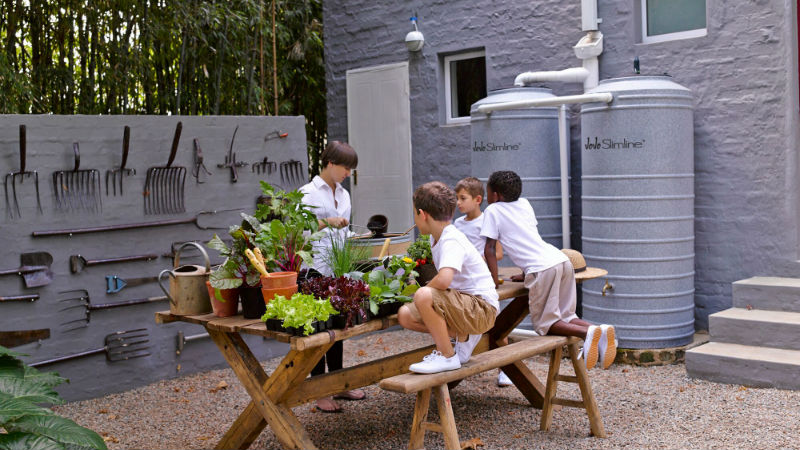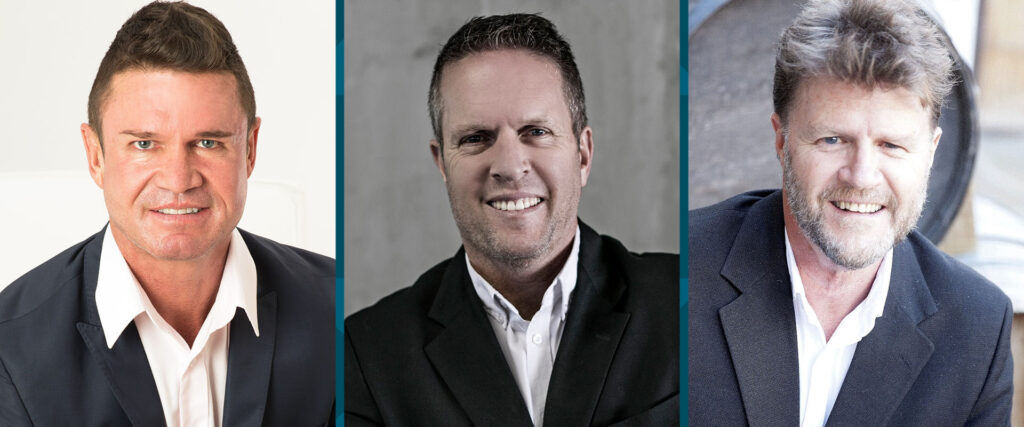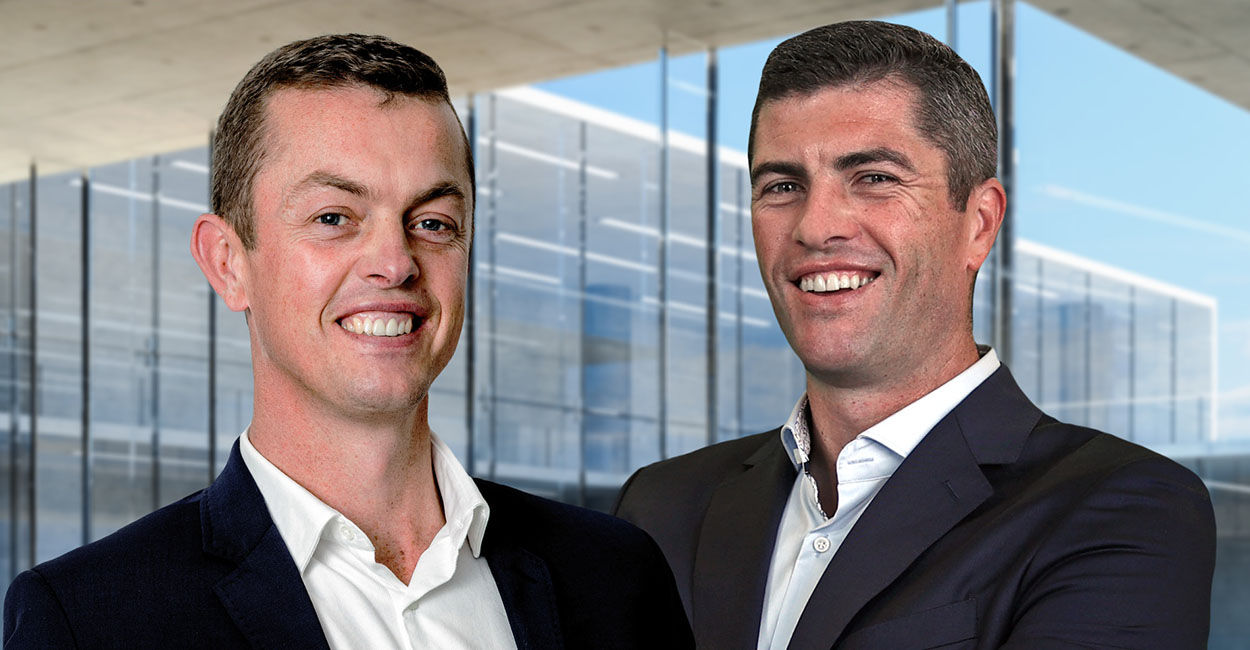MAIN IMAGE: Berry Everitt, CEO Chas Everitt International property group; Roelof Rabe, director Roelof Rabe Architects; Anthony Stroebel, head of New Business Development Pam Golding Properties.
Residences equipped with green technology, especially energy saving systems, are becoming more sought after and for more reasons than you may think.
Despite its massive solar potential, South African’s electricity tariffs have increased by more than 510% between 2007 and 2020 – with a further 15% spike in tariffs since April this year. Similarly, the average municipal water tariffs have soared by almost 1 300% between 1996 and 2020.
It therefore comes as no surprise that homebuyers are keen for their new homes to include energy saving devices to help ease financial pressure on their monthly budget. But what homebuyers perhaps don’t know is that banks are starting to recognise this reduction in risk by offering green home loans.
According to the most recent MSCI Green Property Index, certified green office buildings, being perceived as low risk investments, yield better investment returns than non-certified buildings, and enjoy lower vacancy rates. Furthermore, worldwide evidence is growing that green buildings deliver a multitude of benefits beyond their financial returns. In the US, the percentage of architectural firms expecting to have more than 60% of their projects certified green has grown from 16% in 2016 to 32% in 2018 – and is expected to grow to 45% by 2021.
From the local residential marketplace, there is growing evidence that more homebuyers are keen to invest in a green home or one with energy saving devices.

Green loans
Globally, a green loan is offered by banks to give house buyers better terms, if they can prove that the property for which they are borrowing meets certain environmental standards. Banks are starting to offer a lower interest rate or increase the loan amount available to borrowers looking to buy a green building or renovate an existing building to make it greener.
This means that homes with energy and water saving features will be increasingly attractive to buyers when making their purchase decisions.
In South Africa there is currently one commonly accepted rating of residential homes, the International Finance Corporation’s (IFC) Excellence in Design for Greater Efficiencies (EDGE) residential rating system.
The IFC’s local partner is the Green Building Council of South Africa (GBCSA) who administers Edge certification in South Africa. The Edge certification is awarded when a home uses 20% less energy, water and reduces the carbon footprint of the house building materials by 20%.
Green loans are linked directly to green buildings. They are often either used to build a new home with a sustainability rating, or where the borrower commits to invest in renovating an existing building to significantly decrease its overall impact on the environment.
Grid-free
Energy saving devices are at the order of the day. The country is facing a winter with load shedding looming like a dark cloud and it does not seem as if this problem is going to go away any time soon. The obvious answer to this problem is to get off the national or local electricity supply grid by installing solar power in your home.
The new electricity tariffs that will be implemented in most municipalities in just a few weeks’ time are set to be bigger than usual this year and this will also aggravate the situation. According to Berry Everitt, CEO of the Chas Everitt International property group, these complex power problems have already prompted an increase in demand among existing homeowners for solar geysers, heat pumps, solar (photo-voltaic) panels and other energy-saving equipment. “The installation of such equipment is now one of the most popular types of home improvement, and the trend is being fuelled by the fact that certain banks and finance companies are already offering specific ‘green’ loans to finance these upgrades – or to purchase a ‘green certified’ home,” he says.
Gerhard Kotzé, MD of the RealNet estate agency group, says families are spending more time working and studying from home that their residential electricity usage has risen considerably.
“This has definitely boosted the demand for energy-saving equipment and generators to keep the power on during load shedding. It has also sparked more interest in those towns and cities which are planning to become ‘independent’ of Eskom in the next few years by making use of alternative power sources such as solar and wind.”
According to Kotzé recent research by the South African Cities Network (SACN) shows that the average municipal bill for the four main household types in nine major municipalities in SA (Buffalo City, Cape Town, Ekurhuleni, eThekwini, Johannesburg, Mangaung, Msunduzi, Nelson Mandela Bay and Tshwane) ranges from R1425pm for low-income households, up to R6119pm for high-income households, with electricity charges making up between 42,3% to 54,7% of the bill across the different household types.
Green awareness
At the same time, says Andre van der Merwe, principal of the Chas Everitt franchise on the East Rand, currently one of the busiest new development areas in the country, prospective buyers of new homes have become more aware of the benefits of energy-saving measures which have become almost standard in new developments in the sub-R1m sector of the market, as developers seek to comply with the sustainability and energy-saving provisions of the National Building Regulations.
“We foresee that compliance with these provisions will be increasingly expanded in more upmarket developments to include whole geothermal, wind and solar power provision systems in individual estates as the government steadily opens up private power generation in an effort to meet its international commitments to significantly increase energy efficiencies and cut carbon emissions.”
These sentiments are echoed by Christo Botha of MB Architects: “Solar has become affordable and the payback time is quick compared to other green environment proposals. Buyers are more educated and informed on global warming and this makes it hard to ignore. The big factor is the escalating electrical tariffs as well as power outages that push people to opt for solar efficient houses.”
Natural resources
Roelof Rabe, director at Roelof Rabe Architects, says there is a need for South Africans to relook the way natural resources and energy are used.
“With people working from home more, the actual use of electricity has gone up substantially without employees being reimbursed for additional energy use. The total awareness of energy use at household level was drastically accelerated. Unfortunately, the cost of alternative energy solutions is still very high and most households resort to installing emergency alternative power only to counter load shedding.
“There is definitely not a general trend in going off the grid seeing it is too costly. We think more and more households will invest in supplementary, alternative energy solutions. This can be done by adding additional electricity to the traditional Eskom supply through photo voltaic panels or small wind turbines, simultaneously changing the energy usage pattern to use the power while the source is active. We will definitely see more of this and even more so when City Councils start buying excess power back onto the grid through reversable power meters.”
Anthony Stroebel, head of New Business Development for Pam Golding Properties and a director of the Green Building Council South Africa, says South Africa is already a leader in the growing global green building sector.
“Those seeking a greener lifestyle could either retro-fit their own homes or could purchase or rent a home in a lifestyle estate or a green mixed-use precinct. It’s already becoming apparent that those with the means to do so, are increasingly looking to become more self-sufficient by living completely off the grid,” Stroebel says.

Increased resale value
So, to conclude property owners are increasingly realising that incorporating green living design into their homes is not only significantly contributing to the value of what, often, is their primary asset, but also increasing the ‘sellability’ when they decide to move. A green home typically sells at a premium to other regular homes of a similar size and location and more than likely also sooner.
Furthermore, the construction and use of green or energy saving tech when building or renovating a home also have the following benefits:
- Enhance and protect biodiversity and ecosystems
- Improve air and water quality
- Reduce waste streams
- Conserve and restore natural resources
- Reduces operating costs
- Improve productivity
- Enhance asset value and profits
- Optimize life-cycle economic performance
- Improve indoor air quality
- Low Maintenance and Operation Cost
- Efficient use of resources such water and energy








